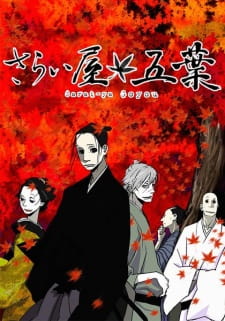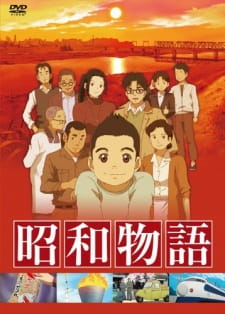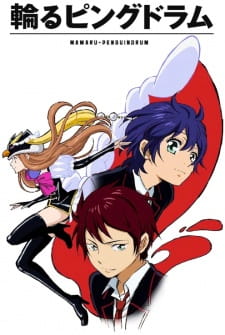[MoCHE] Through history with anime
 •
by
•
by Nanashi Senshi


Greetings citizens of eJapan and eworld, recently I read an interesting article about how history of Japan is represented in anime series, so I decided to (re)publish here on erep (here is the original article). It's not uncommon that history is being used as a inspiration for many movies/series and Japan is no exception in this rule. Many anime series are inspired and set in some specific age of history (mostly The Sengoku era), but they are not very historically accurate so if you are looking for historically accurate show you better skip the most of the anime series xD So here is a list of anime series placed in various historical period of Japan that are more or less historically accurate or at least trying to incorporate real life events in their show.
And last but not least important, it's time to say goodbye, see you next time xD The mandate of this month MoCHE is near to end, so I just wanted to thank all the people who supported us, I hope you enjoyed and also a big thanks to our CP - Silent Warrior and Dr.Jekica for giving me opportunity to work in MoCHE
😁

7. Heian period, 794 to 1185 (Otogi Zoshi)

The Heian era marked the height of Japan's imperial aristocracy with a focus on the arts and setting the stage for the samurai. Despite it's peaceful namesake, there was plenty of behind-the-scenes power grabs between the country's most influential families. This conflict is reinterpreted in Otogi Zoshi. The anime's setting and characters is mix of the medieval novels that it takes its name from; chronicling an adventure to retrieve the magatama that has parallels to the quest for the Holy Grail and real Heian period samurai folk heroes.
See also: Shonen Onmyouji for more supernatural flare taken from the period's strong focus on Buddhism, Taoism, and China.

6. Sengoku period, 1467–1603 (Hyouge Mono)

If you can dream it up, there's a Sengoku version of it. All the generals are girls? Beautiful bishonen? Oda Nobunaga is a gun? A robot? That exists. What's harder to find is a series with less gimmick and more accuracy. Hyouge Mono does that by presenting the period through Furuta Sasuke, a trusted vassal of Nobunaga. The series focuses on the legendary general and his affections for Western aesthetic. Hyouge Mono also goes over many of the major assassinations, deals, and conflicts that plagued the time period but the show is a "thinking man's" series over action. Conversations on Wabi-sabi and other schools of thought are all a part of the political landscape.

5. Edo period, 1603–1868 (House of Five Leaves)

Following the rise of the Tokugawa government, a strict social hierarchy was established with samurai above the majority working class. The era would come to the end with the fall of Tokugawa around the same time that Commodore Matthew Perry fired on the isolated country to force open trade. The strict social castes led to miserable, segregated existences for anyone not lucky enough to be born into the right social class. The House of Five Leaves Masanosuke Akitsu suffers a similar fate as a ronin, a masterless samurai. Despite his once lofty status, Akitsu would be expected to kill himself after the loss of his master and in not doing so, is considered shameful. The story follows him when he begins to work as a bodyguard for burakumin, who undertake shady dealings in Edo.
See also: Intrigue in the Bakumatsu - Irohanihoheto, The Dagger of Kamui, Oh! Edo Rocket

4. Meiji period, 1868–1912 (Rurouni Kenshin)

As the West pushed into Japan, the Imperial Court began to deconstruct the caste system of its predecessor for a more Western approach, marking the final days of the honorable samurai and their many perks. There is probably no better known series taking place in the Meiji era than Rurouni Kenshin. Seemingly affable, Kenshin wanders through Japan's changing landscape looking to atone for his murders during the Bakumatsu years. He clashes with Shishio Makoto, a man looking to overthrow Meiji government that betrayed him and develop Japan into country focused on "survival of the fittest."
See also: Peace Maker, Laughing Under the Clouds

3. Taisho period, 1912-1926 (Otome Yōkai Zakuro)

The Taisho era marks further Western influences in Japan from clothing to democracy. Still, the country makes a push in China, taking both island territories and areas into the North. There aren't a lot of anime set in the relatively short Taisho-era, but military motifs are almost always present. Otome Yōkai Zakuro is one series, although it adds an "alternate timeline" element to excuse the use of spirits. The main character is a half-spirit girl named Zakuro who feels opposed to the new government agency overseeing spirits and the Westernization of Japan (she refers to it a "Jesuit"). The agency pairs members of the Imperial Army with spirits, so each type of characters represent the ongoing conflict of the time period and the attempt to marry traditional Japanese ideas with Western government.
See also: Night Raid 1931, which takes place in China but has the Japanese invasion as a prominent backdrop.

2. Showa period, 1926–1989 (Showa Monogatari)

Both the Sengoku and the Showa period are popular time periods to set a story in anime, the latter for the inherit drama surrounding World War II. Thanks to a huge focus in public school history classes, most Americans are familiar with World War II and there are a number of anime and manga that examine the repercussions of Hiroshima and Nagasaki available. That said, the decades after 1945 are usually overlooked. Showa Monogatari is set in 1964, the same year as the Tokyo Olympics (also the backdrop of From Up On Poppy Hill). The story follows one normal Japanese family in a time where a country is looking to make its come back on a global scale. The patriarch, Yūzō is a former military veteran working in a factory and often finds himself at odds with his college-age son. He works as a stand-in for the older generation raised during an Imperial-focused Japan and the new generation (his kids).
See also: Rainbow - Nisha Rokubō no Shichinin, Zipang, Grave of the Fireflies, Kids on the Slope

1. Heisei period, 1989 to current - (Penguindrum)

It probably seems weird to recommend a show with a magic penguin hat, ghostly pink-haired man, and penguins as a series to define "now." At it's core, Penguindrum is a show about the lost decade within the Heisei period, the children born after Japan's economic bubble burst, and a generation attempting to break away from the mistakes of their parents. Even when your parents committed domestic terrorism. If there is a cultural characterization for the ongoing Hesei period to be found in anime, it's the loss of identity in an increasingly connected world (Serial Experiments Lain), frustration with mediocrity (chunbiyo), and the rejection of cultural exceptions for self (NEETs, hikikomori). These increasingly common character traits and themes, although usually treated as an interesting or humorous character quirk, in anime from the last five years, could be considered the result of the particular era Penguindrum focuses on over 26 episodes.
See also: Paranoia Agent

Also here are the current results of the religion of eJapan poll:


Your Ministry of Culture, History and Education team:
Minister - Dr.Jekica
Vice Minister - Nanashi Senshi


Comments
voted
what about inuyasha?
Also part of the Sengoku period~ So, 1467 to 1603.
[removed]
What are you talking about, InuYasha TOTALLY happened! How could you have missed the thousands of volumes on the demon dog sightings in Central Japan?
Like I wrote at the start of text, the listed anime series are exception, different from the rest, because they try to be more ( or less) realistic, focused on real life events from japanese history and try to be historically accurate as much as they can be. The majority series just use Sengoku era or the samurai era just for the setting, the time where the story happens...they don't have any connection with real life historical events. InuYasha is one of them.
ah ok sorry
No need to apologise. You asked a question and I answered ( sorry if it seems a bit aggressive, that was not my intention ). I'm always glad to see people interested in our articles and anime, especially if they are not from eJapan😁
v
vV
That is a nice selection. I'd like to add Shigurui as a rare presentation of true samurai life (ofc exagarated as well) and Edo period.
good article
o: !
v
V